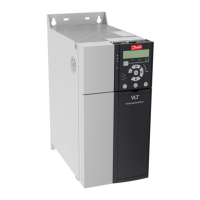a communication error between the power card and the
control card.
Check the alarm log for the report value associated with
this warning.
If the report value is 1, there is a hardware problem with 1
of the fans. If the report value is 11, there is a communi-
cation problem between the power card and the control
card.
Fan troubleshooting
•
Cycle power to the drive and check that the fan
operates briey at start-up.
•
Check for proper fan operation. Use parameter
group 43-** Unit Readouts to show the speed of
each fan.
Power card troubleshooting
•
Check the wiring between the power card and
the control card.
•
Power card may need to be replaced.
•
Control card may need to be replaced.
WARNING 25, Brake resistor short circuit
The brake resistor is monitored during operation. If a short
circuit occurs, the brake function is disabled and the
warning appears. The drive is still operational, but without
the brake function.
Troubleshooting
•
Remove the power to the drive and replace the
brake resistor (refer to parameter 2-15 Brake
Check).
•
In parallel drive systems, check the brake parallel
connections.
WARNING/ALARM 26, Brake resistor power limit
The power transmitted to the brake resistor is calculated as
a mean value over the last 120 s of run-time. The
calculation is based on the DC-link voltage and the brake
resistor value set in parameter 2-16 AC brake Max. Current.
The warning is active when the dissipated braking power
is higher than 90% of the brake resistor power. If option [2]
Trip is selected in parameter 2-13 Brake Power Monitoring,
the drive trips when the dissipated braking power reaches
100%.
WARNING/ALARM 27, Brake chopper fault
The brake transistor is monitored during operation and if a
short circuit occurs, the brake function is disabled and a
warning is issued. The drive is still operational but, since
the brake transistor has short-circuited, substantial power
is transmitted to the brake resistor even if it is inactive.
WARNING
OVERHEATING RISK
A surge in power can cause the brake resistor to
overheat and possibly catch re. Failure to remove power
to the drive and remove the brake resistor can cause
equipment damage.
Troubleshooting
•
Remove power to the drive.
•
Remove the brake resistor.
•
Troubleshoot the short circuit.
WARNING/ALARM 28, Brake check failed
The brake resistor is not connected or not working.
Troubleshooting
•
Check parameter 2-15 Brake Check.
ALARM 29, Heat sink temp
The maximum temperature of the heat sink has been
exceeded. The temperature fault does not reset until the
temperature drops below a
dened heat sink temperature.
The trip and reset points are dierent based on the drive
power size.
Troubleshooting
Check for the following conditions:
•
Ambient temperature too high.
•
Motor cable too long.
•
Incorrect airow clearance above and below the
drive.
•
Blocked airow around the drive.
•
Damaged heat sink fan.
•
Dirty heat sink.
For drives in enclosure sizes D and E, this alarm is based
on the temperature measured by the heat sink sensor
mounted inside the IGBT modules.
Troubleshooting
•
Check fan resistance.
•
Check soft charge fuses.
•
Check IGBT thermal.
ALARM 30, Motor phase U missing
Motor phase U between the drive and the motor is
missing.
Troubleshooting Service Guide
MG94A502 Danfoss A/S © 02/2019 All rights reserved. 71
6
6
